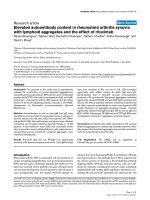Industrial policy in britain 1945 1951 economic planning, nationalisation and the labour governments
Bạn đang xem bản rút gọn của tài liệu. Xem và tải ngay bản đầy đủ của tài liệu tại đây (13.05 MB, 239 trang )
This page intentionally left blank
Industrial policy in Britain 1945-1951 is an archive-based study of the
economic planning of the Attlee governments, in which the author
seeks to analyse the interaction between the decisions of central
planners and the micro-economic effects of those decisions.
Throughout the book, Martin Chick pays particular attention to the
level, pattern and quality of fixed capital investment. At the same time,
there is a continuous concern with the struggle between politicians,
economists and industrialists over the mix of pricing mechanisms and
administrative orders which were to be used in this period. This
struggle permeated all discussions of matters such as the organisation
and structure of nationalised industries, the allocation of resources and
the promotion of higher productivity. The author also asks what
impact, if any, economic planning had on the productivity performance
of the UK economy.
Industrial policy in Britain 1945-1951
Industrial policy in Britain
1945-1951
Economic planning, nationalisation and
the Labour governments
Martin Chick
University of Edinburgh
HI CAMBRIDGE
UNIVERSITY PRESS
PUBLISHED BY THE PRESS SYNDICATE OF THE UNIVERSITY OF CAMBRIDGE
The Pitt Building, Trumpington Street, Cambridge CB2 1RP, United Kingdom
CAMBRIDGE UNIVERSITY PRESS
The Edinburgh Building, Cambridge CB2 1RP, United Kingdom
40 West 20th Street, New York, NY 10011-4211, USA
10 Stamford Road, Oakleigh, Melbourne 3166, Australia
©Martin Chick 1998
This book is in copyright. Subject to statutory exception
and to the provisions of relevant collective licensing agreements,
no reproduction of any part may take place without
the written permission of Cambridge University Press.
First published 1998
Printed in the United Kingdom at the University Press, Cambridge
Typeset in Plantin 10/12 [CE]
A catalogue record for this book is available from the British Library
Library of Congress Cataloguing-in-Publication Data
Chick, Martin, 1958- .
Industrial policy in Britain, 1945-51: economic planning, nationalisation, and the
Labour governments / Martin Chick.
p. cm.
Includes index.
ISBN 0 521 48291 7 (hardback)
1. Industrial policy - Great Britain - History - 20th century.
2. Great Britain - Economic policy - 1945- .
3. Great Britain - Politics and government - 1945- . I. Title.
HD3616.G72C47 1997 338.941'009'045-dc21 97-10272 CIP
ISBN 0 521 48291 7 hardback
Hatty's book
Contents
List of tables
Preface
Acknowledgements
List of abbreviations
1 Economic planning
page x
xi
xiv
xvi
1
2 New Jerusalem?
16
3 Allocating resources
41
4 Nationalisation
72
5 Monopoly pricing
103
6 Appraising investment
137
7 Planning rationalisation
166
8 Return to the market?
197
Index
216
IX
Tables
2.1 Gross domestic fixed capital formation as a percentage
of GNP, 1938-53
page 22
2.2 Gross domestic fixed capital formation at constant market
prices, 1938-52
22
2.3 Gross domestic fixed capital formation in new buildings
and works, 1948-51
23
2.4 Gross domestic fixed capital formation in manufacturing
34
industry, housing and social services, 1948-51
43
3.1 Planned annual allocations of steel, 1946-9
3.2 Investment Programmes Committee: approved programmes
45
and outcomes, 1948-51
3.3 Investment Programmes Committee: deviation between
actual/approved investment, 1949-52
59
6.1 Load factors and thermal efficiency in the electricity
industry, 1922-60
156
Preface
The Attlee governments of the period 1945-51 are popularly associated
with the establishment of the National Health Service, the implementation of the Beveridge Report, and the nationalisation of major
industries. What is generally less well known is that the Attlee governments also presided over a period of economic planning unique in
British peacetime history. While the postwar rationing of food remains a
keen memory for many, and is a staple of popular television and radio
documentaries, there is less awareness of other aspects of postwar
planning. The duller details of the operation of price controls, import
controls, and building licences are understandably less memorable. Yet,
at the end of World War II, the potential ability to combine these and
other controls into an effective system of economic planning occasioned
much excitement in political circles. Economic planning and nationalisation appeared to offer an opportunity to reconstruct and modernise
an economy more efficiently and effectively than the free market could
ever do.
This book examines the development and effectiveness of economic
planning and nationalisation during the Attlee governments. The
particular concern is with industrial policy and the impact of economic
planning on industrial fixed capital investment. There is a slightly
anachronistic ring to 'industrial policy', a term more common today
than in the 1940s. Yet, a system of economic planning which forced
government to make decisions concerning the allocation of resources,
also forced government in practice, if not in theory, to develop what we
would now recognise as an industrial policy. Of particular interest are
the decisions concerning the allocation of resources to industrial
investment. Investment is commonly seen as an important source of
economic growth and increased productivity, and as a measure of an
economy's willingness to forego current consumption in the hope of
enhanced consumption in the future. One of the most serious criticisms
made of the Attlee governments has centred on the accusation that they
failed to give sufficient priority to the needs of industrial investment,
xii
Preface
preferring instead to squander resources on their 'New Jerusalem'
health, housing, and social security programmes. Such criticisms are
examined in this book, as are the factors which influenced the resource
allocation between industries. If complaints about the cost of the
welfare state have long been the standard fare of noisy pubs and genteel
dinner parties alike, then so too have criticisms of the performance of
the nationalised industries. With much of the Attlee governments'
nationalisation programme now unwound by privatisation, it is worth
asking why anyone ever thought nationalisation was a good idea, and
whether fundamental problems were inherent in the original structure
and operating principles of the nationalised industries.
This book is organised into three sections. The first three chapters
examine the early changes in the machinery of economic planning
(chapter 1), the influence of economic planning on the level of industrial
investment (chapter 2), and the criteria and factors which influenced
the allocation of resources between competing industries (chapter 3).
The second section of the book examines the nationalisation programme, in both its origins and structure (chapter 4) and the early
arguments concerning the rules for pricing (chapter 5). This latter
chapter proceeds from its initial concern with the specific arguments
over marginal and average cost pricing in nationalised industries, to a
wider discussion of the use made of pricing mechanisms in general. The
purpose of this is to lead the discussion beyond the confines of central
government, and out into the myriad of boardrooms and construction
sites where economic planning and the market met.
In the third section of the book, the impact which economic planning
had on the investment decisions made by industrialists is examined.
Chapter 6 examines the plant choices made by mangers in the
nationalised electricity and railway industries, while chapter 7 examines
the attempts of planners to promote rationalisation and modernisation in the textile and iron and steel industries. In both of these
chapters, attention is paid to the interaction between the aspirations
and exhortations of politicians and planners, and the information and
signals sent to managers through the system of economic planning. The
question posed is whether the incentives offered to managers were
likely to encourage them to act as planners intended, or whether
economic planning sent out a confusing set of signals in which
increased output was bought at the expense of productivity improvements. The final chapter of the book examines the drift away from
economic planning and the discussions within government of which
controls a Labour government might wish to retain. The book closes by
considering the effects of economic planning on the productivity and
Preface
xiii
growth performance of the British economy., and nudges the reader to
speculate on whether the British experience of economic planning had
much in common with the more durable experience of much of eastern
Europe.
Acknowledgements
Many people have helped me during the writing of this book. Among
the archivists who guided me through their collections, I am particularly
grateful to Terry Whitehead, Andrew Burns (British Steel), Kalina Page
(ICI), Richard Storey, Alistair Tough (Modern Records Centre,
University of Warwick), P. Johnson (Courtaulds), Angela Raspin
(British Library of Political and Economic Science), Michael Moss
(University of Glasgow), Stephen Bird (Labour Party), Henry Gillett
(Bank of England), and all the staff at the Trades Union Congress, the
Chemical Industries Association, 3i, the Electricity Council and the
Public Records Office, Kew. I never fail to be amazed by the apparently
limitless willingness of archivists to go and fetch yet more boxes for me
to trawl through.
These archives are scattered all over Britain, and my journeying was
made easier by the friends and relatives who were prepared to
accommodate me. Thanks again to Simon and Sarah Blandy, Mary and
Tim Wood, Peter and Pat Chick, Peter and Verrall Dunlop, Margaret
and Andrew Underwood, and Julie Bourke, all of whom have put me up
and put up with me over many years.
In thinking and writing about the issues in this book, I have benefited
greatly from discussions with historians and economists, some of whom
were themselves at the centre of events in industry and government
during the Attlee governments. Paul Addison, John Banasik, Sue
Bowden, Duncan Burn, Sir Alec Cairncross, Roger Davidson, James
Foreman-Peck, David Greasley, Trevor Griffiths, Leslie Hannah,
Douglas Jay, John Kinross, Bob Millward, Neil Rollings, Jim Tomlinson, and Peter Vinter have all variously listened to my latest
enthusiasm, answered my questions, or prompted me to think anew
about the issues. I hope they think that this book was worth some of
their trouble.
Finally, and mostly, I am quite unable to say how much I owe to
Hatty, Freddy and Tom. At a practical level, I am extremely appreciative
of the grace with which Freddy and Tom allowed me to commandeer
Acknowledgements
xv
their computer, when my ten-year-old machine expired, taking most of
the book with it. Yes, I did have back-ups. I am also hugely grateful to
Hatty for all the Saturday mornings that she has taken the boys to their
various sporting and dramatic activities, leaving me to chase paper
around the study. This book is dedicated to Hatty as a small and
inadequate expression of my love and thanks.
Abbreviations
BEA
BISF
BKEA
BLPES
BOAC
BSA
CEB
CEPS
FBI
GDFCF
GPO
IPC
IWP
LNER
LPA
NCB
NHS
NIC
NSHEB
OEEC
PRO
TUC
UGA
xvi
British Electricity Authority
British Iron and Steel Federation
Bank of England archive
British Library of Political and Economic Science
British Overseas Airways Corporation
British Steel archive
Central Electricity Board
Central Economic Planning Staff
Federation of British Industries
Gross domestic fixed capital formation
General Post Office
Investment Programmes Committee
Investment Working Party
London and North Eastern Railway
Labour Party archive
National Coal Board
National Health Service
National Investment Council
North of Scotland Hydro-Electric Board
Organisation for European Economic Co-operation
Public Records Office, Kew
Trades Union Congress
University of Glasgow archive
1
Economic planning
'Peace-time planning, in any serious sense, began in the year 1947'. 1
(E. A. G. Robinson, Economic Planning in the UK, p. 3)
A lot can happen during a three-week holiday in Cornwall. Returning
from a holiday begun on 26 July 1945, the economist James Meade
'came back to a totally different world: the United Kingdom had a
Labour Government with a huge majority; the future of the world had
been totally altered by the dropping of two atomic bombs; and the war
in the Far East was over. The situation when I got back was quite
transformed.'2 By the time of his return, the announcement of the
general election results had brought to power a Labour government
committed to nationalising the coal mines and the leading utilities,
determined to effect improvements in health, housing, and welfare, and
concerned to pursue low rates of unemployment. In a remarkable
legislative programme the basis for both the postwar welfare state and
increased government involvement in the economy was to be established. Much of what the later Thatcher governments sought to
reorganise and reform had its origins directly in the legislative
programme of the 1945-51 Attlee governments.
The immediate task confronting the government was to supervise the
transition of the economy from a wartime to a peacetime footing. This
had been effected once before, after World War I, and lessons were
drawn from that experience. Then, the rapid release of controls was
held to have contributed to an inflationary boom in 1919-20 followed
by a slump in which unemployment had risen within a few months in
the second half of 1920 from 4 to over 20 per cent. Inequity was held to
1
2
E. A. G. Robinson, Economic Planning in the UK: Some Lessons, Cambridge University
Press, 1967, p. 3.
S. Howson and D. Moggridge (eds.), The Collected Papers of James Meade: vol. IV, The
Cabinet Office Diary, 1944-46, London, Unwin Hyman, 1990, p. 114, entry for 26
August 1945. The general election was held on 5 July 1945 but the result was not
announced until 26 July to allow time for the votes of those serving in the forces to be
counted.
1
2
Industrial policy in Britain, 1945-1951
have accompanied the inflationary scramble for resources. Work by the
historian Tawney and the economist Pigou provided academic confirmation of the perceived detrimental economic and distributive
consequences of the early release of World War I controls.3 Concerned
to prevent a recurrence of an inflationary boom and slump, and equally
concerned to secure 'fair shares' in the distribution of scarce resources,
the Attlee government had few misgivings about retaining many of the
wartime controls.4 Whatever the arguments over rationing, there was a
wide scepticism about the benefits alleged to proceed from the operation
of free, uncontrolled markets.5
The retained controls varied in their range and longevity. Many of the
most visible were intended to endure throughout the transition period,
but then to be abolished as increased production reduced shortages.
Many consumer controls fell into this category, consumer rationing
controls covering less than one-third of consumer spending in 1948,
and never more than one-eighth from 1949. In 1948 over half of
consumer spending on food was not subject to rationing.6 Many of
these controls provided the bulk of Harold Wilson's 'bonfires' of
controls from November 1948.
Beyond the controls which were most obviously designed to ease the
transition from a wartime to a peacetime economy, there were two
further important groups of controls. The first and increasingly
important group of controls were those intended to promote exports
and to restrain imports. The import controls covered four-fifths of food
and raw-material imports and two-thirds of total imports, including
manufactures, in 1946. On the export side, direct controls over steel,
timber and scarce materials directed resources to leading export
industries as well as giving priority to essential basic sector and bottleneck industries such as iron and steel, coal mining, and building
materials. These controls were reinforced by building-licence controls,
which also sought to ensure that priority was given to the building of
3
4
5
6
R. H. Tawney, 'The Abolition of Economic Controls', Economic History Review, 13
(1943), pp. 1-30. A. C. Pigou, Aspects of British Economic History, 1918-1925, London,
Macmillan, 1947, the research for which was undertaken during the war at the request
of the wartime government. Papers from Tawney and Pigou were circulating around
Whitehall towards the end of the war.
LPA RDR 267 Post War Finance Sub-Committee, 'Full Employment and Financial
Policy', April 1944. LPA RD 75 'Inflation', November 1947.
Ina Zweiniger-Bargielowska, 'Bread Rationing in Britain, July 1946-July 1948',
Twentieth Century British History, 4, 1 (1993), pp. 57-85. UGA, McCance Papers,
Nuffield 24th Private Conference on 'The Government's Controls of Industry and
Trade', 26 and 27 June 1948. Contribution by Sir John Woods.
Alec Cairncross, Years of Recovery: British Economic Policy, 1945-51, London, Methuen,
1985; university paperback 1987, p. 334.
Economic planning
3
council houses and to investment in the traditionally depressed Development Areas. With the growing importance and awareness of the
balance-of-payments problems, key controls retained their importance
longer than originally expected, some gaining an added lease of life
during the Korean War rearmament programme. Direct controls on
most steel, which had been scrapped in May 1950, were reinstated in
February 1952 before finally expiring in May 1953.7
The other set of controls were those intended to contribute to the
planning of an economy in which approaching unemployment was
counteracted by government manipulation of fixed capital-investment
activity.8 Such thinking, with its deep Liberal Party roots, emanated in
the 1930s from groups such as the XYZ group and the New Fabian
Research Bureau, many of whose discussions became familiar to a
future generation of government ministers and advisers, including Hugh
Gaitskell, Douglas Jay, James Meade, Hugh Dalton, and Evan Durbin.9
Dalton, the Attlee government's first Chancellor of the Exchequer, was
keen to give physical embodiment to attractive ideas, and in January
and February 1946 he began to organise the establishment of the
National Investment Council (NIC). Drawing on established countercyclical trade theory, the NIC was to prepare a 'shelf of projects which
could be held in readiness for implementation when downturns in the
trade cycle began to manifest themselves.10 Dalton was chairman of the
NIC, whose membership included a mix of friends and XYZ
members.11 Established with typically ebullient apparent self-confi7
8
9
10
11
Cairncross, Years of Recovery, p. 338-9. The controls of sheet steel and tinplate were
not lifted in May 1950.
PRO CAB 134/982, 'Investment in 1953 and 1954', Report by the Investment
Programmes Committee, 3 January 1953, p. 5, para. 2. 'It was contemplated in the
1944 White Paper on Employment Policy that the Government's power to influence
the level of investment should be used to maintain the level of employment.'
S. Howson, British Monetary Policy 1945-51, Oxford, Clarendon Press, 1993, p. 63.
J. C. R. Dow, The Management of the British Economy, 1945-60, Cambridge University
Press, 1970, p. 214. PRO 134/982, 'Investment in 1953 and 1954', Report by the
Investment Programmes Committee, 3 January 1953, para. 2. PRO T288/81, Letter
from Hugh Dalton to Sir Clive Ballieu, 17 January 1946. BKEA Gl/247, Letter from
Dalton to Lord Catto, 15 January 1946.
The members 'chosen for their wide knowledge and experience of financial, economic
and industrial questions' included Lord Catto (Governor of the Bank of England);
William Piercy, the first chairman of the newly established Industrial and Commercial
Finance Corporation, which was to assist in improving the supply of capital to small
and medium-sized companies; Sir Robert Pearson (Chairman of the Stock Exchange);
Lord Kennet (Chairman of the Capital Issues Committee); Sir Albert Gladstone
(Chairman of the Public Works Loan Board); Lord Hyndley (Chairman of Finance
Corporation for Industry, before leaving to become chairman of the National Coal
Board); C. E. Prater (Co-operative movement); Sir Clarence Sadd (Midland Bank); Sir
Clive Baillieu (President of the Federation of British Industries); Nicholas Davenport,
and George Gibson. PRO T288/81, letters from Hugh Dalton to Sir Clarence Sadd,
4
Industrial policy in Britain, 1945-1951
dence, the achievements of the NIC must have proved a disappointment
to Dalton. Its fundamental raison d'etre was undermined by the failure
of the expected slump to materialise and in its short life, prior to being
wound up by Stafford Cripps in December 1948, it tended to discuss
rather marginal issues such as relaxing the wartime ban on companies
issuing bonus shares.12
The fate which befell Dalton's ambitions for the NIC also attended
his complementary approach to planning in which capital issues
controls assumed a central position. The NIC and the 'control of
demands on the capital market' through the Capital Issues Committee
formed the basis of Dalton's 'planning of investment' and his antislump measures.13 Whatever the long-term potential of such instruments, Dalton's claim in 1946 that these financial controls provided the
basis for 'effective planning' in an economy in which companies often
had high levels of accumulated savings seems overly sanguine. To
Meade, Dalton's claim was 'absurd' and 'pure eye-wash', being 'no
more a proper control of investment than anything we had before the
war'.14
The real constraint on investment activity was the shortage of
building materials, steel, timber, and labour.15 Indeed, it was the
predominance of physical-resource shortages, and the secondary importance of finance, which in part allowed Dalton to operate the cheap
money policy with which he is so closely identified.16 Cheap money had
many attractions for government. It reduced the cost of servicing the
national debt of around £25,000 million, with a floating debt component of £7,000 million; it was consistent with the aim expressed in
the coalition government's 1944 White Paper on employment policy of
avoiding 'dear money in the Reconstruction'; it was held to be in
keeping with the longer-term anti-slump measures; and it reduced the
cost of raising money for the reconstruction and nationalisation
programme.17 The stock issue in compensation for the railways was
12
13
14
15
16
17
Lord Hyndley, and Lord Piercy, 17 January 1946. M. Chick, 'William Piercy', in
D. Jeremy (ed.), Dictionary of Business Biography, vol. IV, London, Butterworth, 1985.
BKEA Gl/247, 'National Investment Council, Members', 5 February 1946.
Howson, British Monetary Policy, p. 121.
PRO T288/81, National Investment Council, Paper 5, 'Note on the Work of the
Investment Working Party', November 1946, para. 5. BKEA Gl/247, letter from
Dalton to Lord Catto, 15 January 1946.
Meade, Diary, 2 December 1945.
PRO CAB 134/440, IPC(49)3, Cabinet, Investment Programmes Committee, Report
on Capital Investment in 1950-1952, para. 61.
For a detailed analysis of Dalton's cheap money policy, see S. Howson, British Monetary
Policy.
PRO T233/299, Paper on 'Cheap Money' by H. A. Copeman, 17 March 1947, paras.
1, 3, and 4. For a critique of Keynes' General Theory and the cheap money policy see
Economic planning
5
expected to amount to over £1,000 million, that for electricity to
around £350 million, while the housing programme was thought likely
to require that the government borrow £500 million.18 Dalton was
understandably keen to pursue cheap money. Loans raised at higher
rates of interest would form correspondingly high capital charges on the
assets represented by the loans, and in turn would require the rents of
new houses and the prices charged by the National Coal Board (NCB)
and other public corporations to be increased. Since increased prices
were held to contribute to inflationary tendencies, cheap money could
be presented as being anti-inflationary.19 This contrasted with the view
articulated in some sections of the Conservative Party that interest rates
should be raised precisely so as to dampen inflationary tendencies.
What was not clear was how high interest rates would have to go to have
any such effect. If the intention was to take immediate measures to
dampen demand and to promote savings, then a more direct option was
to run a budget surplus. Compared with the potential impact of a
budget surplus, dearer money was dismissed by planners, such as Alec
Cairncross, at the Board of Trade, as 'largely a red herring5.20
Before a move could be made to attempt to balance income and
expenditure by such means as a budgetary surplus, a number of major
adjustments had to be made to the structure and assumptions of
immediate postwar economic planning. It had to be recognised that
excess rather than deficient demand was the principal persistent
problem, and that budgetary techniques offered at least as much scope
for managing excess demand as the phalanx of price controls and
allocating committees. Such a shift in perspective would require
central, physical planners such as the Lord President, Herbert
Morrison, to step to one side and allow the Treasury a greater role in
'economic planning'. Such significant changes were never likely to be
conceded easily, and it was only on the back of the two crises of 1947
18
19
20
BKEA A D M 14/16, 'Cheap Money: A Criticism of Lord Keynes' Theory and an
Alternative View' by Lucius P. Thompson-McCausland, March 1945. His criticism
that Keynes' General Theory was too concerned with the outlook of the speculative
investor rather than that of businessmen was supported by Dennis Robertson. BKEA
A D M 14/16, Letter to L. P. Thompson-McCausland from Henry Clay, Warden,
Nuffield College, Oxford, 11 April 1945. BKEA A D M 14/16, Letter to L. P.
Thompson-McCausland from James Meade, 23 April 1945. Letter to T h o m p s o n McCausland from D . H . Robertson, 19 March 1945.
For possible alternative bases for compensation see Frederick Geidt, 'Taking over
Railways: an Annuity Plan', letter, Financial Times, 29 November 1946.
P R O T233/299, paper on 'Cheap Money' by H . A. Copeman, 17 March 1947, para. 4.
P R O T 2 3 0 / 2 5 , letter to R. Tress (Economic Section) from Alec Cairncross (Board of
Trade), 19 June 1947.
6
Industrial policy in Britain, 1945-1951
that substantial changes to the machinery, personnel and outlook of
postwar economic planning were effected.
The two major crises of 1947 were the fuel crisis in February and the
convertibility crisis in August. While a counterfactual £200 million
exports were lost, the political importance of the fuel crisis was probably
much greater than its economic significance, since it raised clear
suggestions of incompetence at the centre of government and cruelly
broke any confidence in the omniscience and effectiveness of planning.
As Dalton remarked, after the fuel crisis it was 'never glad, confident
morning again'. 21 Indeed, it is difficult to refute accusations of
incompetence and weak management at the centre of government.
There was clearly a fundamental excess demand for coal, and, if it were
allowed to continue, a crisis of some sort was entirely predictable. Eight
months before the fuel crisis, James Meade, the Director of the
Economic Section, wrote to Morrison warning him that not only was it
'difficult to exaggerate the urgency of radical action to increase coal
production', but that it was not at all 'impossible that shortage of coal
this winter may so interfere with supplies of fuel for industry as to cause
widespread unemployment and a failure to maintain our economic
targets, including our export drive, and may make it difficult to keep our
homes warm. Such a development, coming on top of the present food
situation, would clearly be disastrous'. 22 Counter-arguments made by
Emanuel Shinwell, the Minister of Fuel and Power, that 'the worst is
over' were regarded by Douglas Jay as 'too optimistic', and that
in fact, as things are going at present, industry, transport and domestic
consumption is bound to be dislocated on a wide and uncontrollable scale by
December or a little later. This easily predictable and avoidable disaster is likely
to occur at exactly the moment when the National Coal Board takes over the
first great nationalised industry in this country. The discredit to the Government
would be as devastating as the dislocation to industry.23
That the predicted fuel crisis did occur highlighted the ability of
planners to extrapolate from existing consumption and production
trends and to forewarn politicians of approaching problems. That,
despite such warnings, the fuel crisis occurred also pointed to the
insufficiency of information alone; in a planning structure there also had
to be at least a commensurate willingness on the part of political leaders
21
22
23
H. Dalton, High Tide and After, London, Frederick Muller, 1962, p. 205.
P R O CAB 124/706, CP(46)232, note from J. Meade to Lord President, 'Output,
Recruitment and Conditions of Employment in the Coal-mining Industry, memora n d u m by the Minister of Fuel and Power', 19 June 1946, para. 1.
P R O CAB 124/706, note entitled 'Coal Crisis' from D. Jay to J. A. R. Pimlott, 19 June
1946, paras. 1-3.
Economic planning
7
to act on the information. The tale of Attlee confronting Shinwell with
the statistics only to be told in reply that he should not 'be led up the
garden path by the statistics', and that rather he 'should look at the
imponderables' did not bode well.24
The political response to the fuel crisis was to replace Shinwell with
Gaitskell as Minister of Fuel and Power, with Gaitskell also being
appointed chairman of the newly established Fuel Allocations Committee. To strengthen the credibility of the wider planning structure, the
establishment of the Central Economic Planning Staff (CEPS) and the
Economic Planning Board was announced during a three day debate on
the economy between 10 and 12 March 1947. These were rushed
creations, the Economic Planning Board being a rather cosmetic,
tripartite talking shop whose members were not appointed until July. Of
much more importance was the CEPS headed by Sir Edwin Plowden,
which, again, did not take up its duties until the summer of 1947 but
which did mark a sharp move towards strengthening the centralised
administrative balancing of supply and demand within the planning
structure.25 The establishment of the CEPS was both a reflection of the
growing concern about the persistence of excess demand and an implicit
acknowledgement that the existing planning structure was experiencing
considerable difficulties with operating in such conditions. For all of
Morrison's boasts of planning, and his self-regard as the 'central
economic co-ordinator', his department had little supervisory central
control over the issue of steel approval forms and building licences by
other departments such as the Ministry of Works.26
There were also pockets of the economy where 'co-ordination' was
conspicuously absent. In a reconstructing economy, resources became
too thinly spread over a growing number of construction projects, few of
which were completed. By 1941, in the Development Areas, which
accounted for half of all the factory building authorised since 1944, only
40 per cent had been started and a mere 6 per cent completed. In the
North West region alone, only 38 per cent of all licensed industrial
building jobs costing over £10,000 were more than one-quarter
complete.27 For all of the government's insistence on learning from the
experience of the economic reconversion after World War I, this over24
25
26
27
D . Jay, Change and Fortune;, L o n d o n , H u t c h i n s o n , 1980, p . 149.
D . N . Chester, ' M a c h i n e r y of G o v e r n m e n t a n d P l a n n i n g ' in G. D . N . Worswick a n d P. H .
Ady (eds.), The British Economy 1945-50 Oxford, C l a r e n d o n Press, 1952, p p . 3 4 4 - 5 .
H e r b e r t M o r r i s o n , Economic Planning, L o n d o n , Institute of Public Administration,
1946. P a p e r read before a m e e t i n g of t h e Institute of Public Administration,
17 O c t o b e r 1946, p . 8. B L P E S , M e a d e p a p e r s , 1/4. Diary, 26 August 1 9 4 5 .
P R O C A B 134/437, I P C ( 4 7 ) 9 , C a b i n e t , I n v e s t m e n t P r o g r a m m e s C o m m i t t e e , Report,
8 O c t o b e r 1947, p . 5, para. 12.









